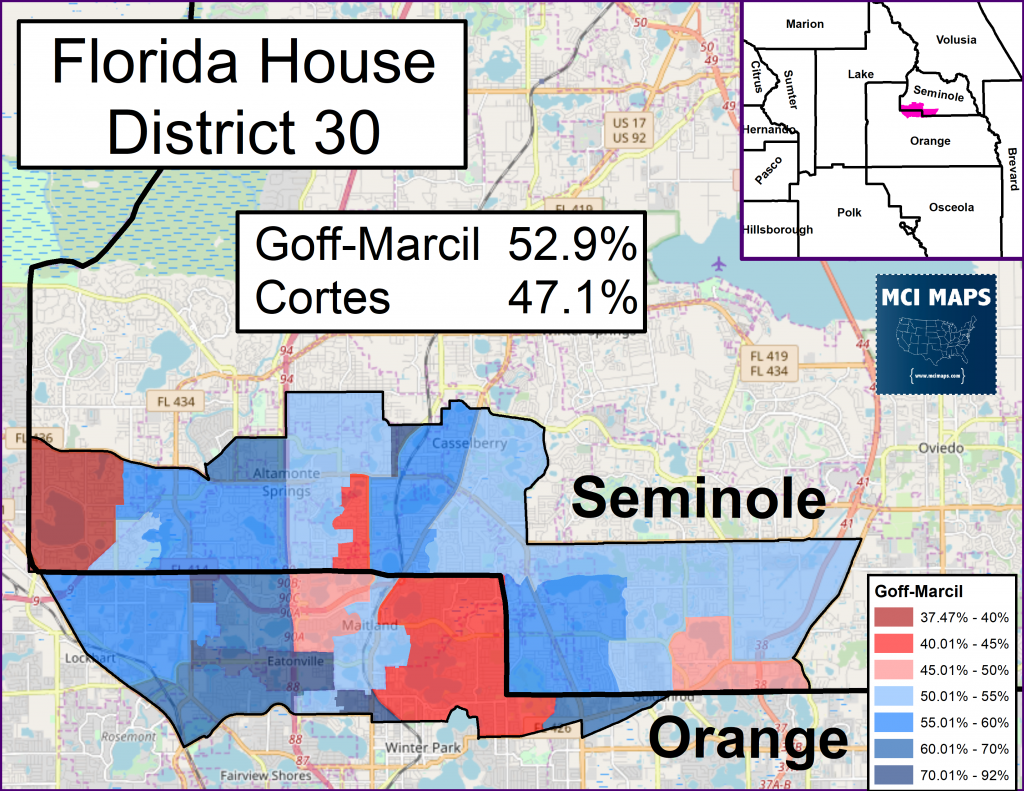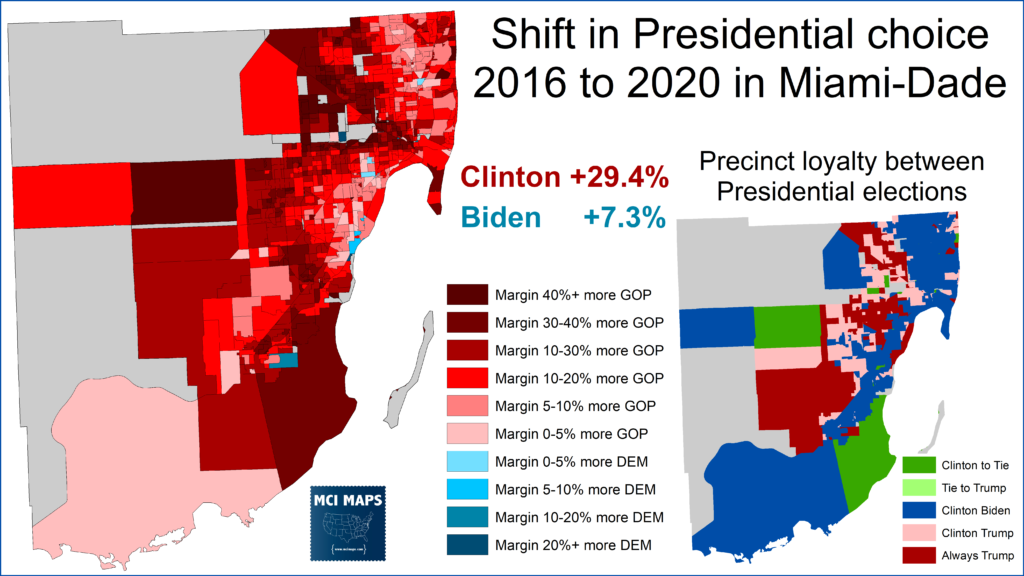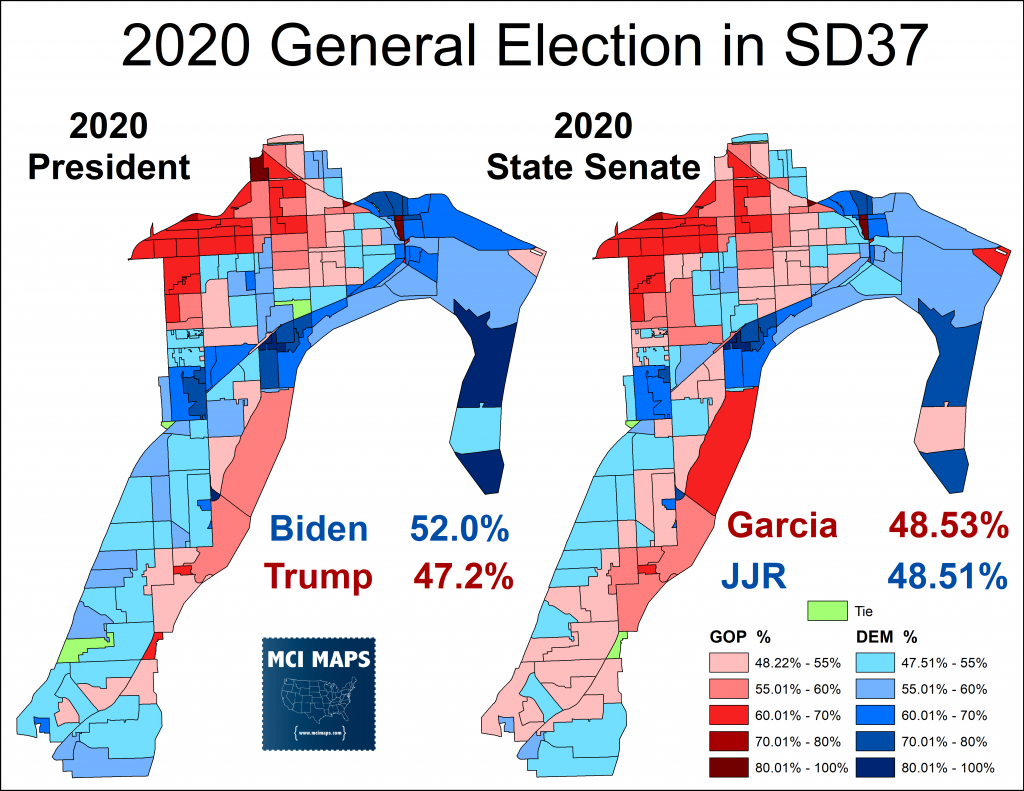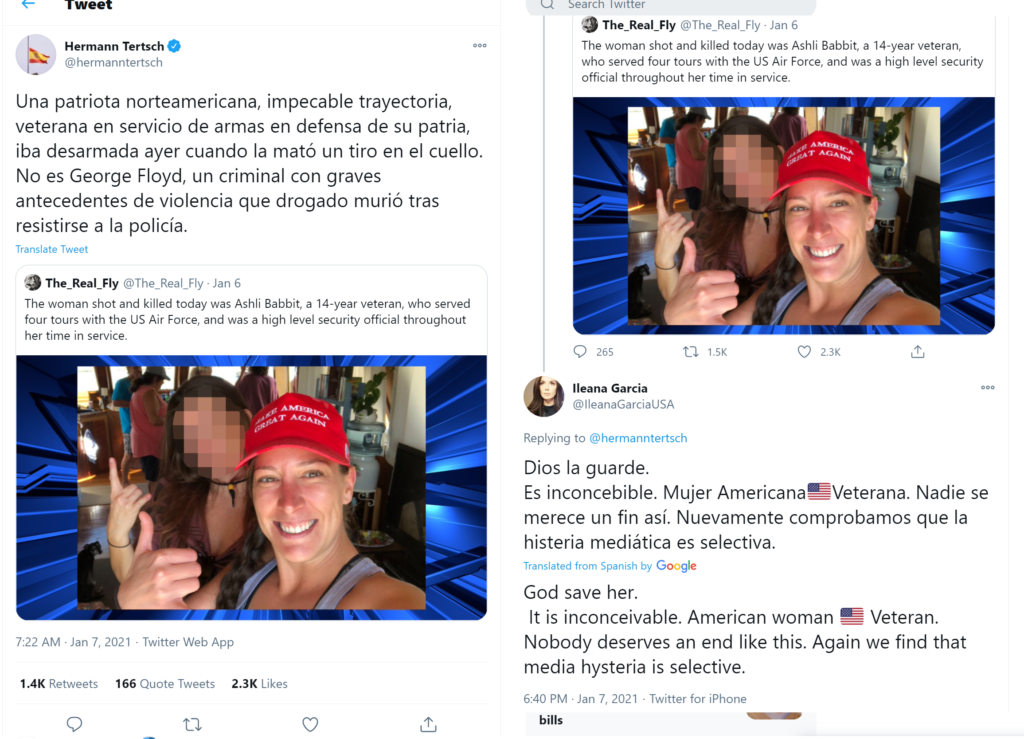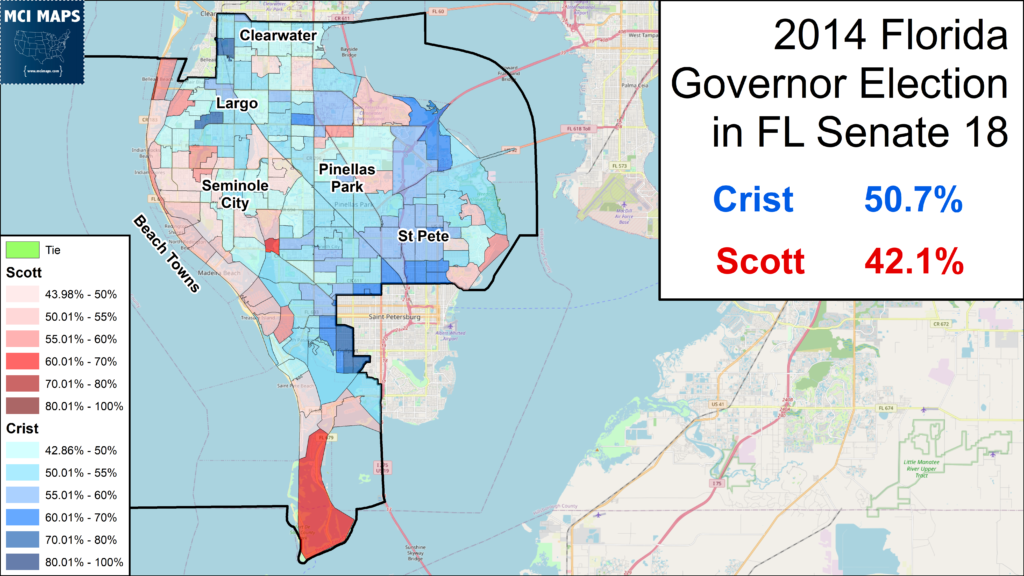In just a few weeks, Florida will hold its midterm elections. Absentee ballots are already out and being returned and campaigns are in their final stretch. While the Gubernatorial and Senate elections are dominating the coverage, there are several high-profile and expensive races for state legislature. For this article, I am going to look at the battle for the State Senate.
The State Senate Map
If you followed my substack series, you know all about the Florida redistricting process of 2021-2022. I invite you to look at my substack archive and this website’s past articles for detailed coverage on how the maps came into place. The Congressional map and its gerrymander dominated coverage, but the story with the state senate and state house is quiet different. Florida’s constitution does not give Governors a say in the legislative maps, only the congressional. As a result, the process for passing legislative plans were much simpler. In the case of the state senate, the process was much less controversial. While the final plan does have some partisan bias – namely how Tampa Bay is treated, the GOP did not go out of their way to craft a hard GOP gerrymander.
In the 2020 Presidential contest, Trump won 24 districts to Biden’s 16. One of these Trump districts, SD36, was decided by under 1,000 votes.
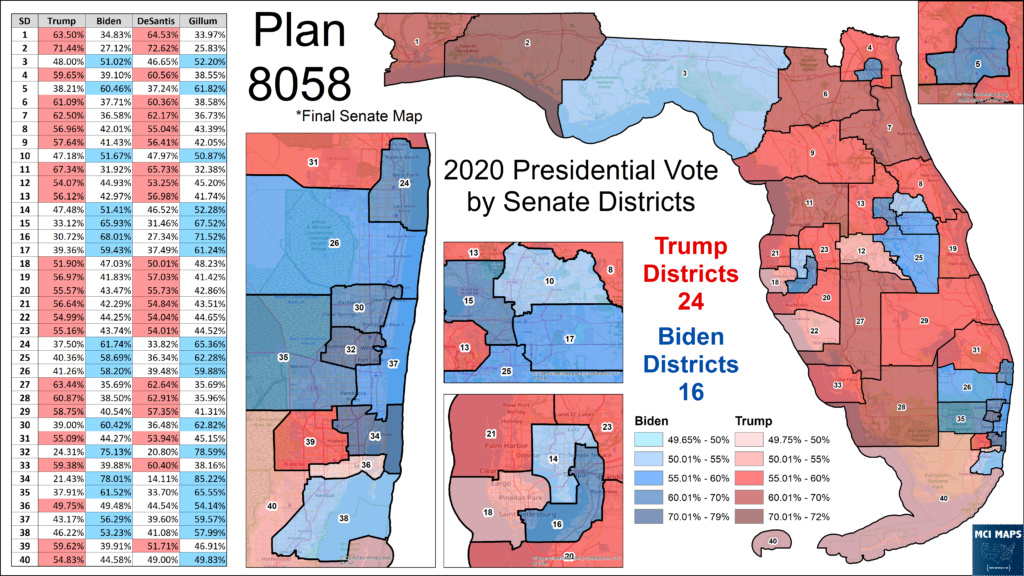
The breakdown in the Governor race was 22 DeSantis seats vs 18 Gillum seats.
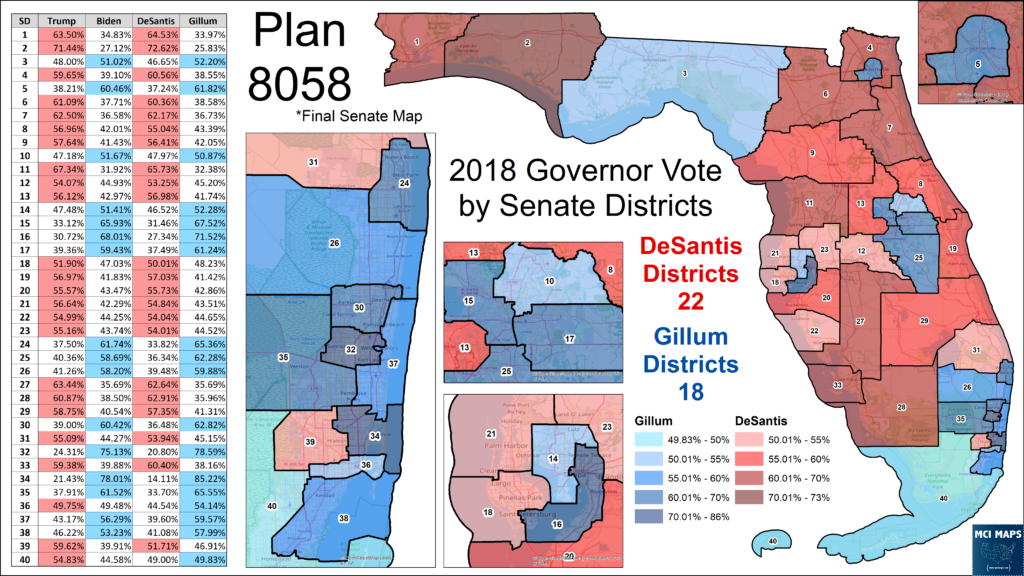
Democrats were going to suffer under redistricting in the map due to population shifts. South Florida was going to lose a Senate district, and since several Hispanic and Black seats are protected, the victim was going to be a white Democrat. This happened and after a game of musical chairs, Senator Gary Farmer opted to run for Circuit Judge in Broward County. The GOP decision to pack black voters across the Tampa Bay water prevented a south Pinellas Democrat-leaning seat. Read my breakdown of the Tampa Bay to see why GOP efforts to cross the water are partisan, not preserving a minority seat.
The other Democratic victim was that a seat anchored around Alachua County was eliminated. Due to population shifts, it would have been tricky to draw a Senate district that kept Alachua whole. While I showed how it could be done here, it wasn’t much of a shock that the GOP opted to cut Alachua up. This is a partisan move but one hard to prove in court without some documentation. In total there are arguably 1-2 seats Democrats could have been more competitive in with a more neutral map.
One continuing x-factor in the partisan makeup of these districts is the future coalitions. The 2020 election showed massive GOP gains with Hispanic voters. In the meantime, Democrats kept improving their margins in the suburbs. The 2016-2020 Presidential swing can be seen below.

Just because a district is or isn’t competetive now doesn’t mean its position won’t change down the line.
So that is a quick breakdown of the State Senate Map partisan lean. I’m going to delve into the district ratings for 2022. All districts are up thanks to redistricting. Any district with an odd number will be up again in two years, while anyone in an even numbered seat won’t be up again till 2026.
Here is topline partisan data for all districts!
Tossup Districts
This year, only one district is what I would call a pure tossup. Several districts at this point show at least a moderate edge to one party or the other. SD10, however, remains a pure coin flip.
Senate District 10
(Conflict note: I am doing data for a third-party group on the ground in SD10)
Covering Seminole and part of Orange County, Senate District 10 is the most up-in-the-air race of the cycle. This seat is effectively the suburban Orlando district, a region that used to be red but has moved to the democrats in the era of Trump. The new seat is largely the same as Senate District 9, which had a contentious election in 2020. In that contest, former State Rep Jason Brodeur narrowly defeated laywyer and first-time candidate Patricia Sigman. The district narrowly backed Joe Biden, but Republicans still have a strong down-ballot edge in suburbs.

However, redistricting put Brodeur in a bad position. Lawmakers cut out the Volusia portion of his district and instead added in northern Orange County. This traded out Trump-backing Volusia precincts for Biden backing Orange precinct, causing his district to become bluer.
The redistricting changes moved SD10 to a Biden +4.5 district. This is an example of GOP map makers not being partisan in their process. Trading Volusia for Orange makes a great deal of sense due to the dense development on the Orange-Seminole border. It made the seat more democratic, but it still came out of a GOP-led committe.
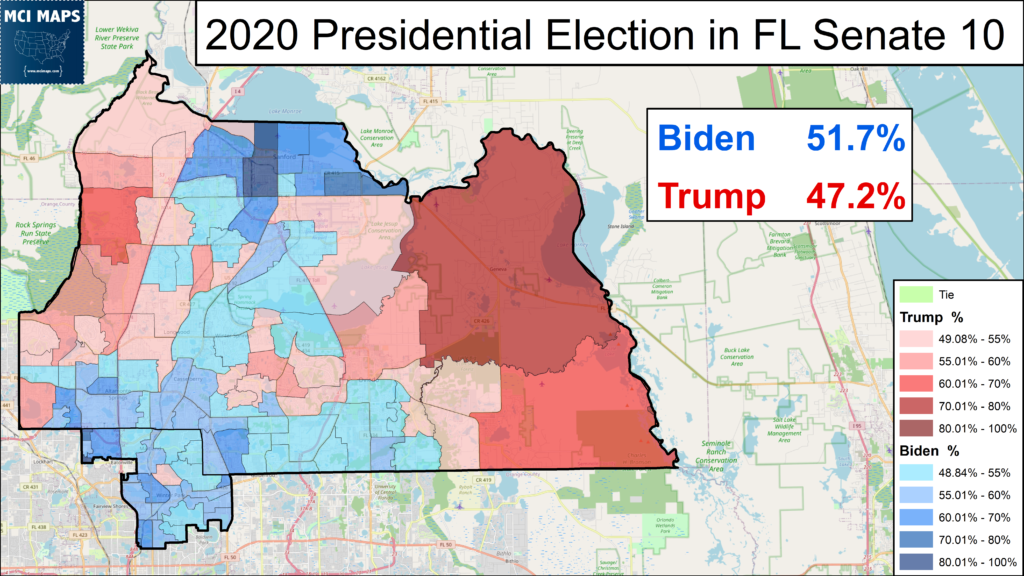
The district is not only a Biden seat, but its a district that has been growing bluer with time. Part of this democratic swing is the growth in non-white voters, especially Hispanics, in the I-4 corridor. I covered this demographic change in this article. The other factor is white suburbanites abandoning the Republican Party. The table below shows top-line data in the new SD10 since 2012.
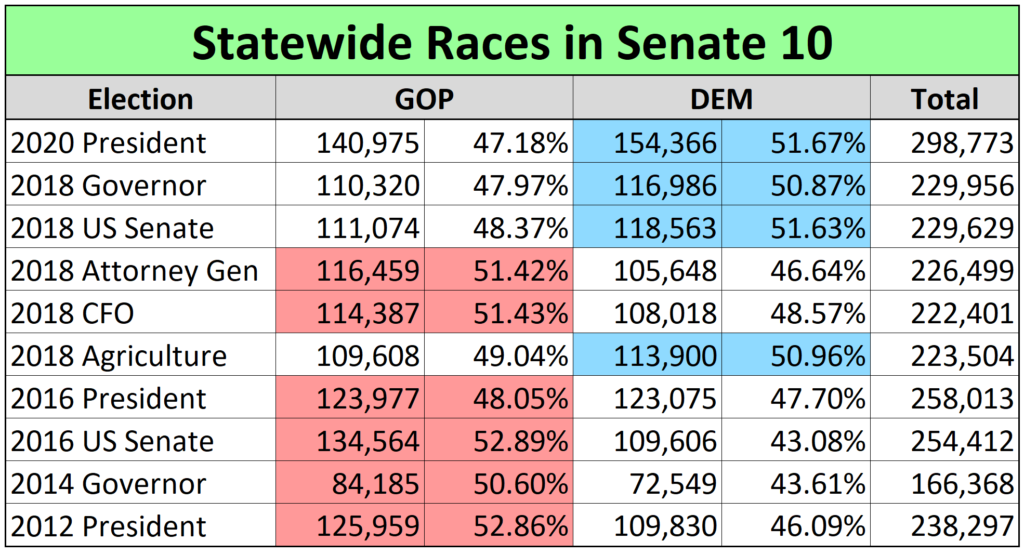
The district has gone from being 8 points to the right of the state in 2012 to 7 points to the left of the state in 2020. Whether these trends hold remains to be seen, as Democrats could always suffer a backslide in suburbia. However, the broad trend is in team blue’s favore.
Brodeur is also not the strongest Republican running for the district. While he’s now an incumbent, the Senator is being dogged by questions around his 2020 campaign. If you have been following Florida politics, you know about the “ghost candidate” scandal. To keep this brief, but I talk much more about it in this substack and this other article, GOP interests recruited third party candidates to run in then-SD9 and then-SD37. These candidates were then propped up with dark-money mailers and advertising framing them as the left-wing alternative to the democrat. In SD37, the 3rd party candidate margin absolutely cost the DEM incumbent his seat (more on that later). In SD10, Brodeur got over 50%, so the scheme wasn’t needed. However, he is now being dogged by it as the Seminole GOP chair is indicted and recently the spoiler candidate in question has claimed Brodeur knew of the scheme. To be clear, the recruiting and tactics are not necessarily illegal. Where consultants are getting into trouble is fraud in filings and campaign finance reports. The illegal actions are causing prosecutions to continue, giving voters deep insight into a shady practice that most voters are disgusted by.
Brodeur is no doubt being hurt by the scandal, especially as corruption issue are something suburban voters can latch onto. Brodeur now faces a challenge from Democratic State Rep Joy Goff-Marcil, who’s current seat covers a good chunk of the state senate district. Goff-Marcil burst onto the seen in 2018 when she knocked off a strong GOP Incumbent Rep Bob Cortes, who was considered the favorite.
Goff-Marcil’s biggest issue, however, is fundraising. Never a strong fundraiser, she has only brought in $110,000 as of this writing. Brodeur, for contrast, has raised over $400,000. On top of this, the flush-with-cash Florida GOP is dumping money into the race, while the Florida Democratic Party, cash poor, is focused other contests and cannot afford to help nearly as much. Trust me, there is millions being spent here. There are third party groups on the ground in the district working to make up that gap (see my note at the start). Everyone on all sides agrees, however, that the GOP resources here far outpace DEM resources.
So the question remains, with the blue-lean of the district and Brodeur’s problems overtake the GOP resource avalanche? Another factor is how the top-of-the-ticket democrats do here. If Crist or Demings only pull off narrow wins in SD10, then Joy likely loses. If they win by 4-5 points, can Brodeur really hang on?
For me, so many questions remain, and both sides have things in their favor or disfavor. This is a pure tossup.
Lean Republican Districts
There is only one race I can characterize as Lean Republican in these ratings. Unfortunately for Democrats, that one race is the seat held by DEM Loranne Ausley.
Senate District 3
Covering Tallahassee and a large chunk of its rural surrounding counties, Senate District 3 has been a democratic guarantee for well over 100 years. This district used to combine the always-blue Tallahassee, rural African-American voters, and rural “yellow dog” white Democrats. The black community here traces a good deal of its history to the old plantations that dotted North Florida.
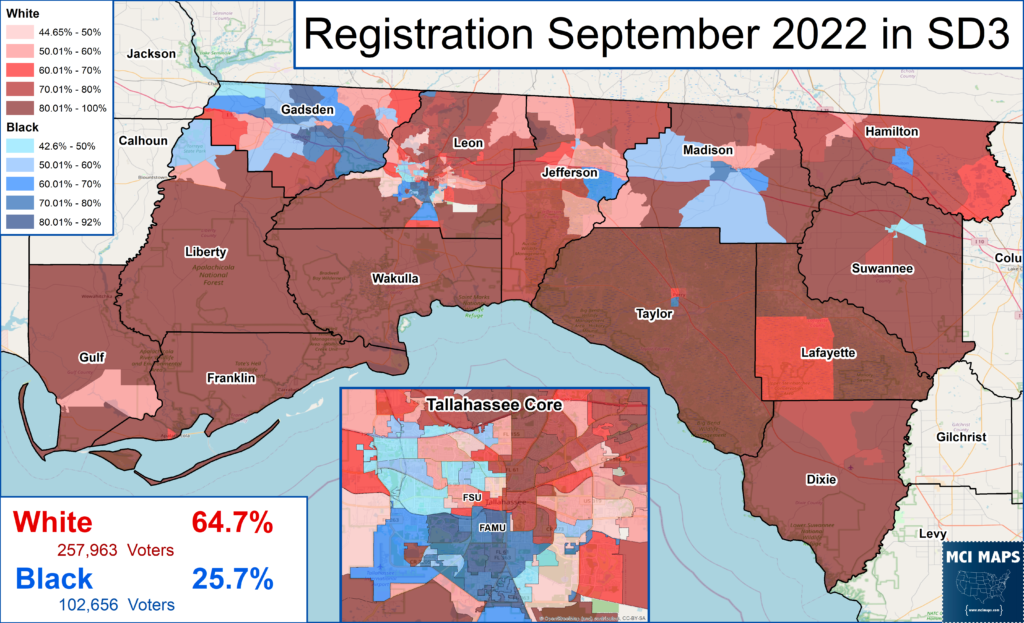
If you read my biography of Al Lawson, you will see how he won a version of this district, the margin was overwhelmingly Democratic. Even as GOP fortunes approved at the top of the ticket, this seat has a down-ballot democratic edge. Conservative democrats covered the area, and all local officials were democrats. Even in 2002, when Jeb Bush crushed Bill McBride by 13 points, the rural counties of the Tallahassee market were blue.
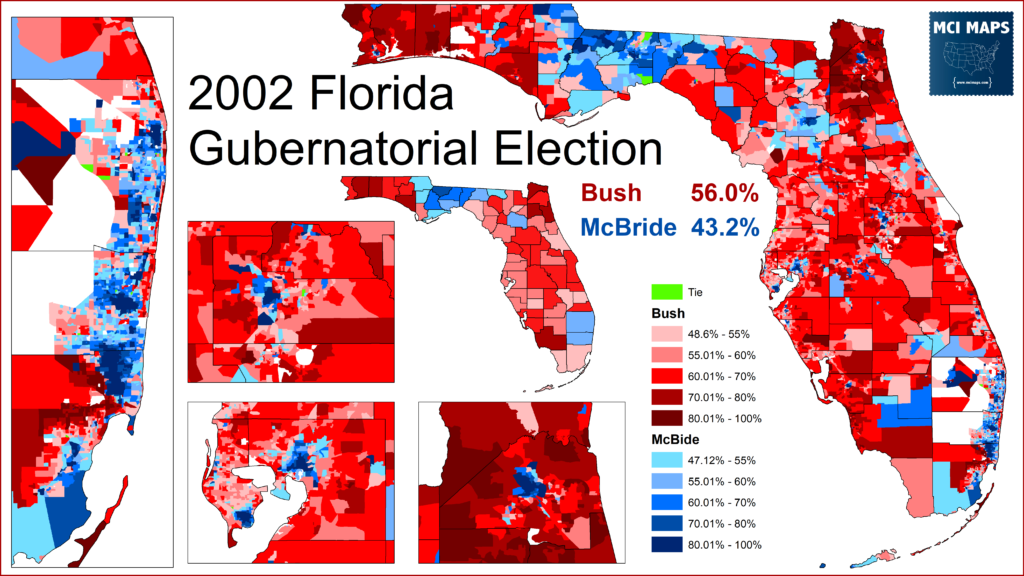
However, coalitions have changed, with rural whites moving deep into the GOP column. Almost all the local democrats are gone, and any democrat wins thanks to liberal Tallahassee and the rural black voters. The new SD3 now sits has a near tossup district, only backing Joe Biden by 3 points. It is heavily propped up by Leon County dominating the share of the vote.

Heading into 2022, the most vulnerable democratic state senator was always going to be Loranne Ausley. A longtime Democratic official in the Tallahassee area, Ausley was state representative from 2000-2008 and again from 2016-2020. She is part of a longstanding political family in the North Florida region, with a grandfather who was a state senator and father who was a prominent attorney.
In 2010, as Ausley was running for State Senate in a primary against former Representative Curtis Richardson and former Leon Superintendent Bill Montford, she was recruited by Florida Democrats to run for statewide office. Ausley, likely sensing the primary for senate would be won by either Richardson, who had a solid African-American base, or Montford, a beloved politician with tons of cash, agreed to make a run for Florida Chief Financial Officer. The run was always viewed as a sacrificial effort. The 2010 midterm was looking like a deep-red year and the Gubernatorial contest was the only real democratic hope. Ausley faced off against Jeff Atwater, who won by 19 points! Democratic fortunes for other cabinet races were just as bad, with Rick Scott’s 1% win being the closest contest. However, while Ausley got blown out statewide, she still won the vote in this Senate District by 16 points!
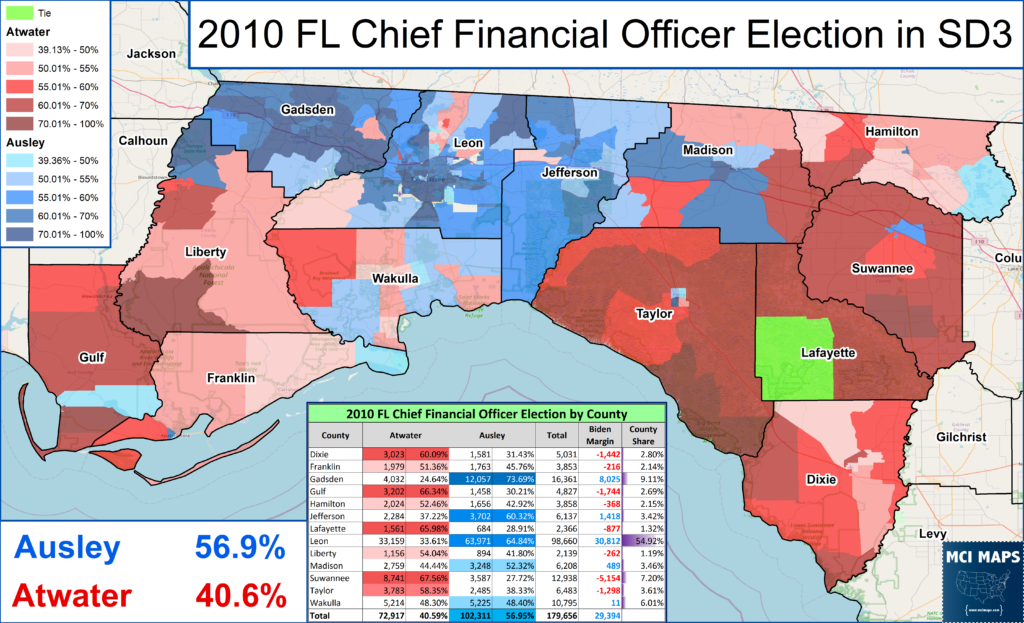
That result is not just a reflection of her family name being an aid, but also the down-ballot democratic strength. This was the time when Democrats still dominated local rural county offices.
However, Ausley now sits in a state senate district that is much redder in the modern environment. This was seen in here initial 2020 State Senate win, which was in a seat that backed Biden by 9 points. Her win in 2020 was against first-time candidate Marva Preston, a retired law enforcement official from Wakulla County. Preston, who is black, put real pressure on Ausley and Democrats had to work to counter GOP advertising into the black community, which is a community Democrats must dominate in to hold on in modern North Florida. Ausley would wind up winning the race by 6 points despite the Republican party dumping over $8,000,000 into the contest. I firmly maintained in 2020 that a loss was unlikely, but that the GOP goal was to force Democrats on the defensive here. It worked.
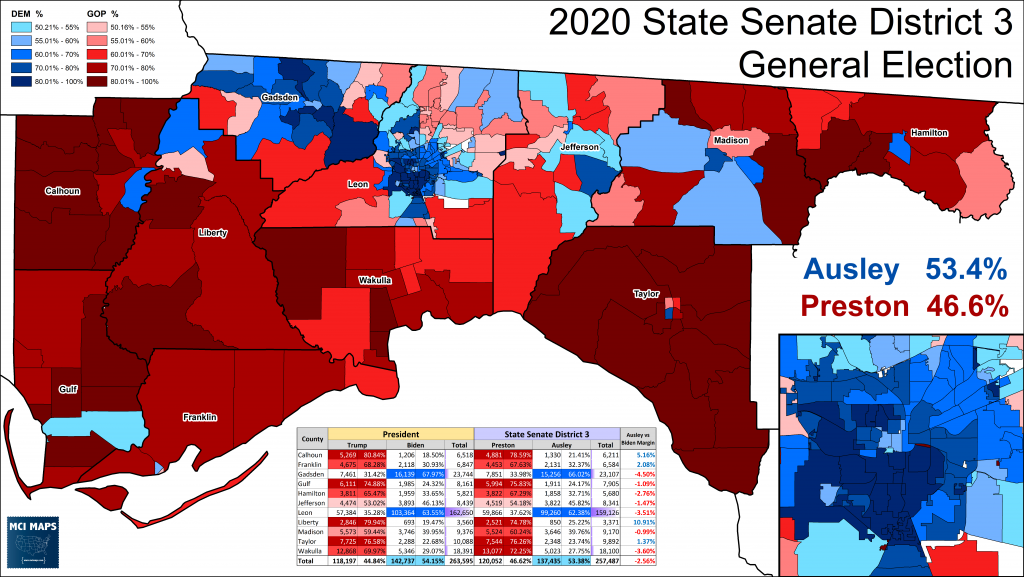
Preston was able to take a decent share of the black vote from Ausley. As the campaign went on, Ausley’s family history, which includes many members who resisted integration, was brought up. This is a sad reality for any modern politician with North Florida ties. As I documented in my Tallahassee Capital City history, the community used to be like any southern town; so much so it closed its swimming pools when integration was mandated. This is not an indictment of anyone running for office now, but it’s a history Ausley and many others have had to account for. Ausley’s politics have certainly not indicated she shares any of her families past prejudices; with her being a presence in the 2020 BLM movement and an advocate for taking down confederate monuments. While Ausley beat Preston, she did 3% worse than Joe Biden, and specifically underperformed in the black community.

While Ausley did worse with black voters, she did better with rural whites.
The rural white communities gave Ausley some added boost, namely in Liberty County; which is the land of old family dynasties. However, these vote blocks are small. There is also no doubt some of these rural white voters will not back a black candidate.
Ausley was always in a tough position for 2022 because it was well understood her district would change. This wasn’t even an issue of gerrymandering; her district was underpopulated and needed to expand. Unfortunately for her, the only option was to expand into more rural, red counties. Before any maps came out, I predicted she’d lose Calhoun County (to the underpopulated SD2) and take Suwannee, Liberty, and Lafayette. That is exactly what happened.
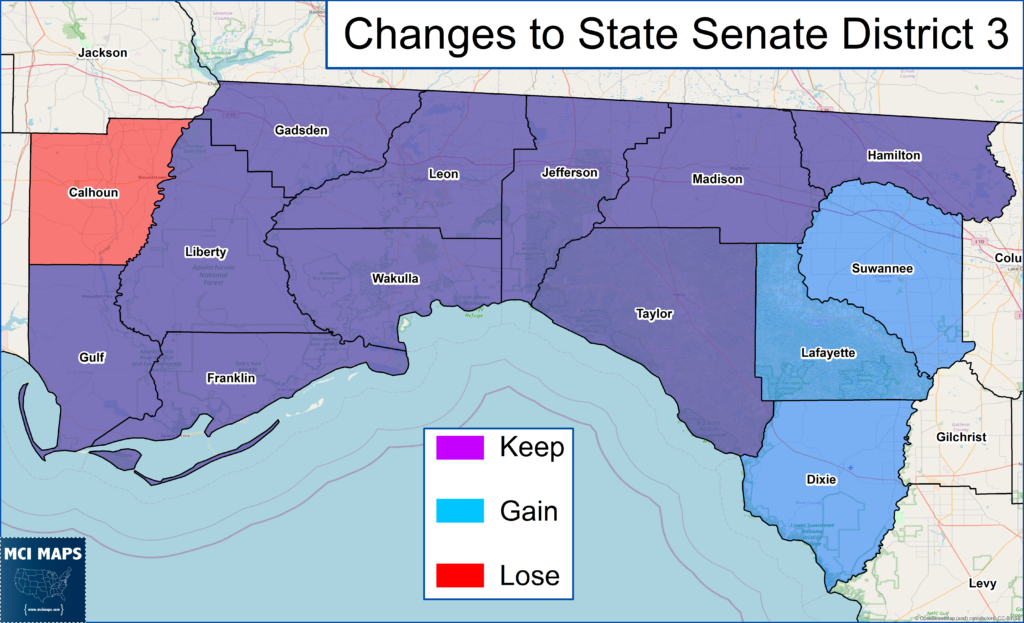
The result is a district that went from Biden +9 to Biden +3. This would already be a bad position for someone who underperformed the top of the ticket and heading into a midterm. It got worse for Ausley when Republicans successfully recruited Corey Simon as the GOP nominee.
Simon was top recruit for the district from the Republican Party. He played for FSU and was part of the 1999 season where FSU won a national championship. He went on to have a successful NFL career. After retiring from football, and as a Republican, he was made the head of Volunteer Florida. His story and career make him a strong recruit for the district.
Word is it took some time to convince him to leave Volunteer Florida to make the move. Republicans almost surely promised Simon, who didn’t get in the race to right around qualifying, that all the money needed would be there. After all, the Florida GOP has mountains more cash than the Florida Democrats. Sure enough Simon has been able to raise not only $300,000 in a short timeline, but there is a flood of GOP-funded advertisements in the district. Turn on your TV and you will see a litany of Simon ads touting his local ties.
For Ausley, the only move has been to go negative. Simon labeled as just a rubber stamp for the Republican Party (in a district Crist should defeat DeSantis in), is Ausley’s only hope. Simon has been tripped up a bit when balancing GOP orthodoxy with the bipartisan image he wants to cultivate. He was caught giving a meandering answer about the question on if Joe Biden fairly won the 2020 election. However, any efforts to paint Simon in a corner have fallen off the rails thanks to what is hands down the most idiotic mailer of the cycle. The Florida Democratic Party (not the Ausley campaign) sent a mailer aiming to tie Simon to the anti-gun control positions of the Republican Party. They decided to run THIS mailer.
The reaction to the mailer has been fierce. Its gotten local press coverage, been decried as racist at worst or offensive at best. To me its very clearly not a purposeful attempt to play the race card – because doing so would be of no benefit to the Ausley campaign. This isn’t 1960s and the Democrats want to win over rural white racists. In 2022, the Ausley playbook to victory is the black community and white liberal democrats in Tallahassee. This mailer undermined support with both groups and is truly the dumbest shit of the cycle.
Even before this mailer, Ausley was already in a weak position. Running against a candidate who likely will get a larger share of the black vote than Preston got in 2020 in a district 6-points less blue than the 2020 map was a bad place to be in. However, while Simon has had only minor hiccups on the campaign, Ausley’s side is drawing bad headlines for itself. On top of this, Simon announced he would not be participating in debates or forums, no doubt worried he’d be pinned on controversial issues. The Ausley campaign, which has plenty of cash, could have gone to these events, gotten photos of her next to an empty podium, and slapped it on some mail pieces. Instead, they Ausley campaign cancelled their appearances too. Needless to say, this is not smart politics.
I think we are are more likely than not heading for a Simon win. So much so I am planning a retrospective on the Tallahassee-North Florida Senate history, which I plan to come out sometime post-midterms. Ausley is in a negative news cycle in a district she was already clinging to. The ground is shifting beneath Democratic feat in North Florida (outside Tallahassee-Gadsden), and Ausley increasingly looks like she will be a victim of it.
Lean Democratic Districts
On the Democratic side of the needle, two districts are showing modest advantages for team blue. One is a strong DEM incumbent in Tampa, and the other is an open seat in Miami-Dade.
Senate District 14
Covering western Hillsborough County, Senate District 14 is a predominantly white and Hispanic district that covers suburbs and urban core in the Tampa metro region. It is held by Democrat Janet Cruz, who was a state Rep that then won the seat in 2018, defeating then-incumbent Dana Young. At the time the district was SD18, but it is largely the same as the new SD14.
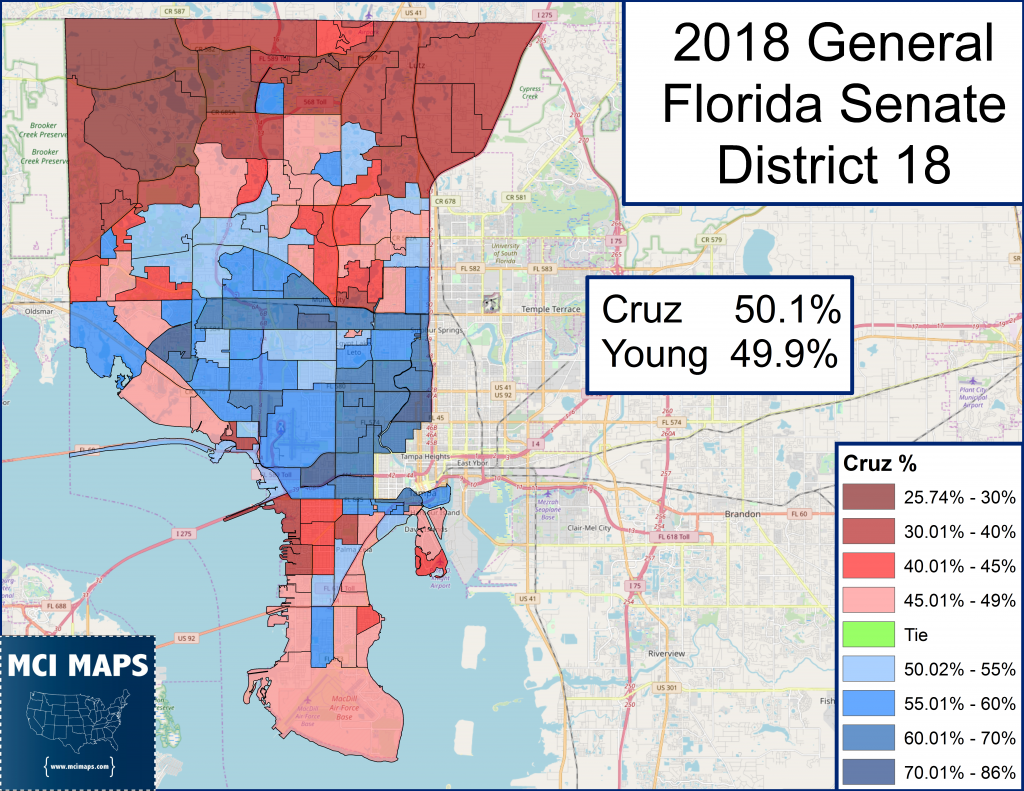
Young was a strong GOP incumbent, who had millions of dollars to spend on the race, far more than Cruz. However, Rep Cruz, who also served as Democratic leader in the house, relied on an aggressive outreach campaign and her ties to the Hispanic community of Tampa Bay to pull off the victory.
The new SD18 made some changes on its central border and added in portions of Northern Tampa – known as “New Tampa.” The district is 60% white in registration, but has several prominent Hispanic communities.
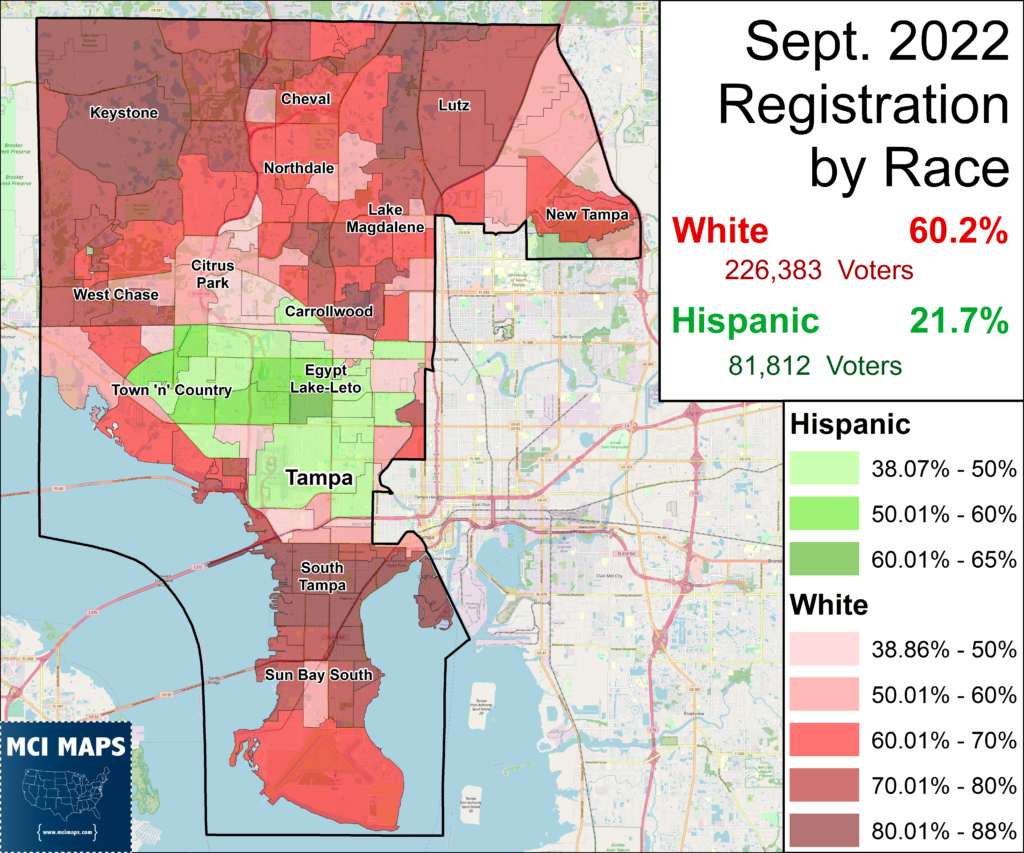
These Hispanic neighborhoods are the areas covered by the house district Cruz once held. That will be critical heading into this race.
In 2020, the new SD14 gave Biden a 4% margin. The norther suburbs/exurbs of Keystone and Lutz are steadily red, while the New Tampa addition is a solid Democratic block of votes. While Biden won many of the Hispanic areas, he lost some precincts, especially those with higher Cuban populations like in Egypt Lake-Leto.
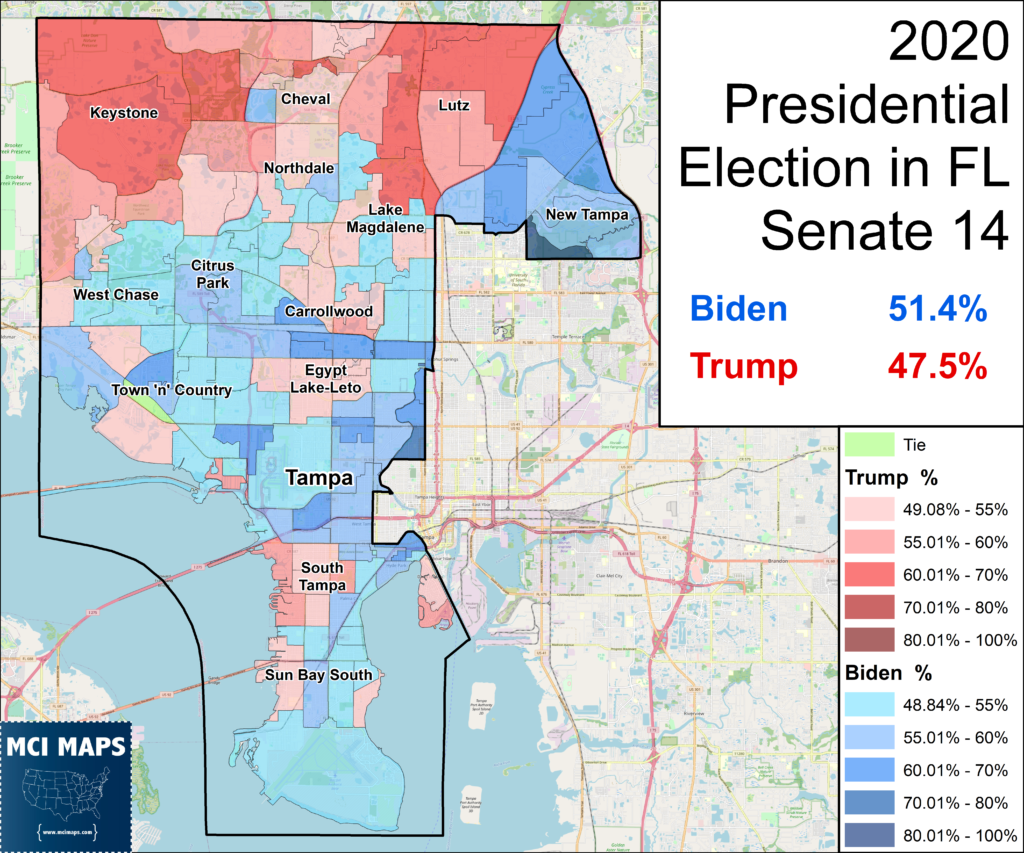
In 2016, Clinton had won this ditrict by almost 6%. While Biden improved in the suburbs, he did much worse in the Hispanic communities. This matches statewide and national trends.
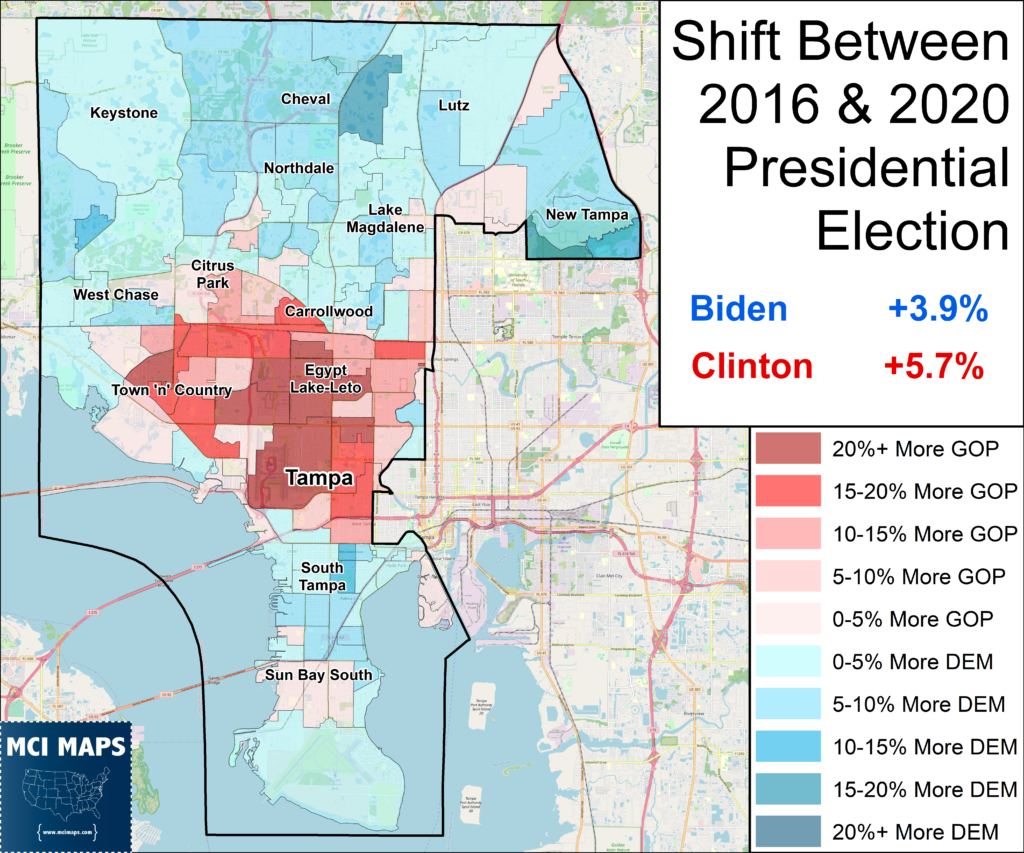
This Hispanic slide is bad for Democrats, but is something Senator Cruz has a good chance of fixing. I fully expect her to overperform Biden in the Hispanic communities. In the 2020 House races, Democrat Susan Valdes, running in Hispanic-access HD62, which overlaps the Senate seat, won by 20% vs Biden’s 14%.
Cruz’s opponent is Jay Collins, a veteran who was recruited by Ron DeSantis for the run. Cruz has far outpaced Collins in fundraising, bringing in nearly $2 million dollars vs Collin’s bringing in under $500,000. The Senate GOP, aided by cash from DeSantis’ campaign, is pumping money into Collins, however. That said, Cruz, unlikely Joy in SD10, has the resources to fight back, and is running an aggressive campaign. Collins, recruited to be a DeSantis yes man, has a good bio but no strong ties (especially compares to Cruz).
Considering the district’s lean, Cruz’s stellar campaign, and demographics, its easy for me to view this as a Lean Democratic race. Not a lock, but odds in favor for team blue.
Senate District 38
While SD14 is Lean Democratic thanks to a strong DEM incumbent, SD38 is lean Democratic due to its top-line data.
Located in coastal Miami-Dade, Senate District 38 has a good deal of overlap with old Senate District 37. The seat goes from the southern port of Miami and heads all the way down to Leisure City, which is just north of Homestead. The district is racially diverse, the least Hispanic of the four Miami-Dade Hispanic majority districts. It has a large white population around the Brickel community of Miami and heading down into Coral Gables and Pinecrest. There are also historic African-American communities in areas like Perrine and Richmond Heights.
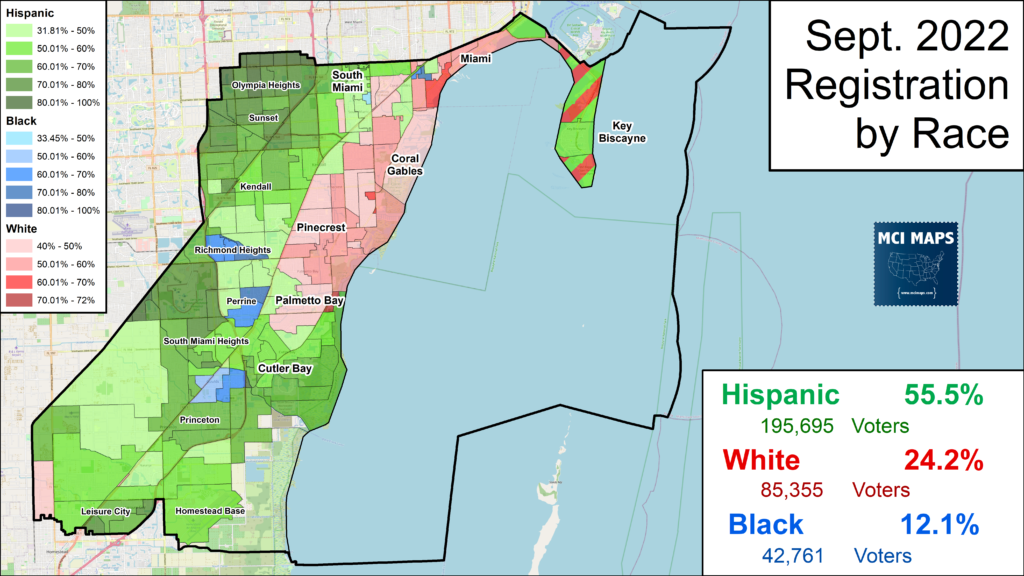
The districts Hispanic community is locates across the district, but the Cuban vote is highest in places like Olympia Heights and Sunset.
In the 2020 Presidential election, Biden won this district by 7 points, his best performance in any of the Hispanic-Majority, Miami-Dade districts.
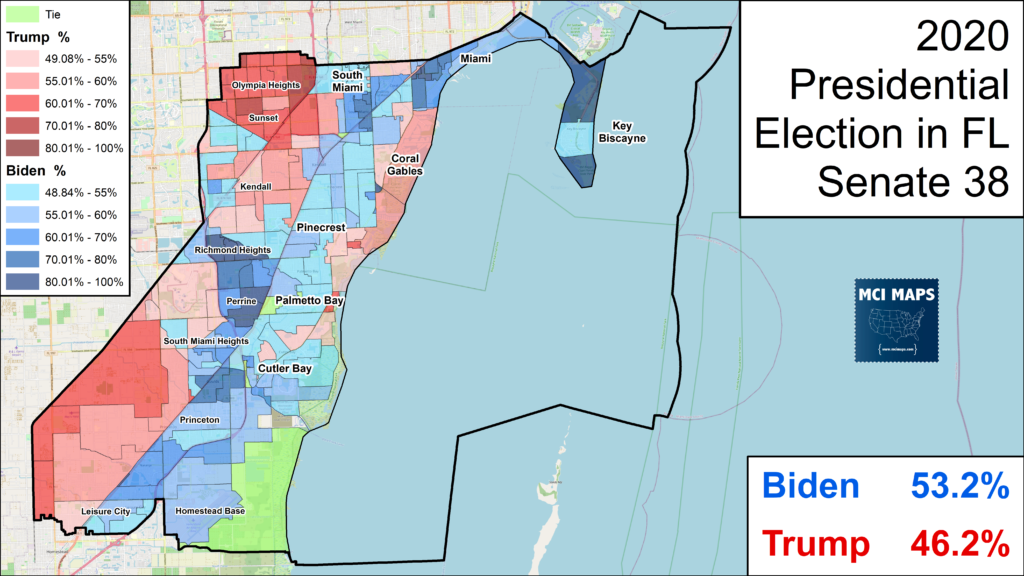
The Biden margin was still a massive slide from Clinton’s 24% win in 2016, or even Gillum’s 19% win in 2018 Governor. The right-wing slide in Miami-Dade was massive, and covered all corners of the state.
The Biden margin is most similar to the 2016 US Senate Race, where Patrick Murphy edged Marco Rubio by 7 points in the district.
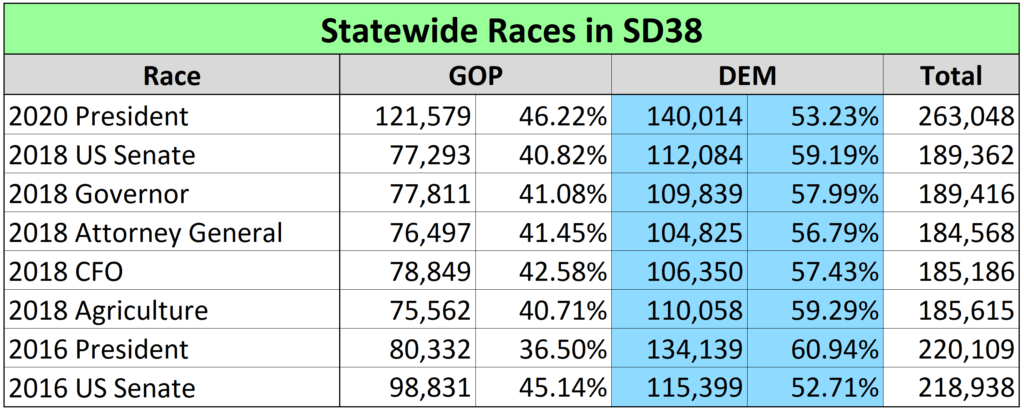
The seat’s small Cuban vote share has made this district the most reliable for Democrats. That said its not considered a safe Democratic hold, and is the home to a multi-million dollar contest.
The democratic nominee is Janelle Perez, a Cuban democrat who runs a heathcare business. Perez, whos parents are part of the exile communities, holds socially liberal positions but is more economically conservative. She pegs herself as a “Miami Democrat” – which holds up. Perez’s is openly LGBT, married to her wife, Monica, and they raise two children. At 28 she was diagnosed with late-stage lymphoma, which is dormant in her body now. Her political work really kicked into high gear years ago when she worked as an intern for Republican U.S. Rep. Ileana Ros-Lehtinen, Dade’s first Cuban congresswoman who also had a strong pro-LGBT voting record. She has raised over $900,000.
The Republican nominee is Alexis Calatayud, a former director at the Florida Department of Education and former campaign manager to GOP State Rep Vance Aloupis. Calatayud has raised over $500,000. Despite less money, Calatayud has plenty of air cover from the Florida Senate GOP. This is the most expensive media market in the country, and trust me, millions are being spent here. Perez is facing plenty of attacks, and is dealing with some progressive grumbling that she is not lefty enough. Miami-Dade can be a black-box when it comes to predictions (well at least if you don’t have access to expensive focus groups). Ticket splitting is common and topline margins are not always a perfect predictor. If Perez were a weaker candidate, a Biden +7 seat would be no democratic guarantee. However, Perez is holding her own in this race, even if she’s being outspent.
The topline data AND Perez’s resources should keep this in Democratic hands. If it falls to the GOP, it will be a massive screw up, and indicative of a worsening situation for Miami-Democrats. I rank this as Lean Democratic, but not as much as I would SD14.
Likely Republican Districts
There are two state senate districts that I would argue are not safe GOP, but have a very clear GOP advantage.
Senate District 36
The race for Senate District 36, which covers parts of the city of Miami, is a district that could be closer on paper, but outside circumstances make a GOP advantage. The district is a mixture of multiple old seats, but namely covers the north portion of the old Senate District 37. This was the other district that was subject to a “ghost candidate” scheme by the FL GOP that aimed to run third-party candidates to siphon off left-wing voters from the democrat. In SD37, independent Alex Rodriguez got 3% after dark-money groups pushed him as a liberal alternative to Democratic Incumbent Jose Javier Rodriguez. Thanks to these efforts allowed Republican Ileana Garcia to pull off a win by less than 50 votes.
While running a candidate as an independent with this goal is not illegal itself, the operatives involved broke several laws in their scheme. This including bribing the spoiler candidate for taking part, lying on campaign filings, and potential other legal schemes. Alexis Rodriguez plead guilty and is now a witness for the prosecution against the ringleader of the plan, former State Senator Frank Artiles. The trial of Artiles has not begun yet, but the scandal hangs a cloud over Senator Garcia.
Garcia does benefit from her new district being redder than the seat she won. Donald Trump narrowly won the new SD36, which is where Garcia is running for another term. The district includes blue communities in the east; namely downtown Miami and southern Miami Beach. However, the district veers west into heavily Cuban and overall red territory.
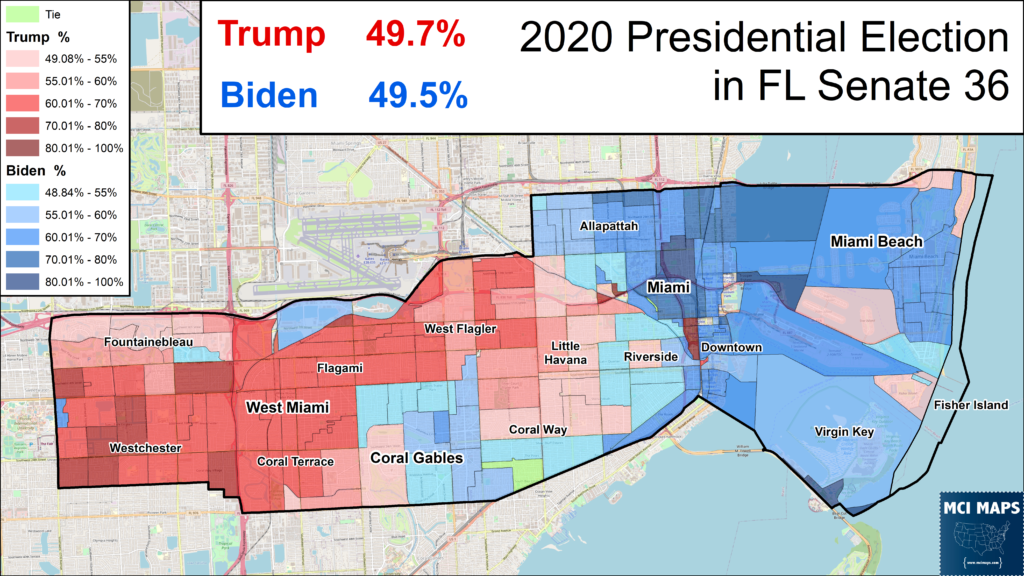
This Biden showing is down from past years, with Gillum winning the district by 10 points. The district could absolutely swing back into a democratic direction if Democrats win back over some of the western district voters. Garcia, meanwhile, has done herself no favors in her two year tenure. A few of these controversies include saying black people should “move on” from racism, claiming homosexuality was a choice, and being a sympathizer for the insurrectionist shot during the capital riot.
After a load of controversies in 2021 and early 2022, Garcia left social media and quieted down. Her reputation for bigotry and and downplaying the capital attack put her right in line with the Proud Boys who have been infuriating the Miami-Dade GOP.
The problem for Democrats in this district is candidates and money. First, lets discuss money. As I mentioned in my SD38 write-up, this is the most expensive media market in the state. Republicans are outspending in SD38, but that district is 7 points bluer. Republican were always going to far outspend any democrat here, propping up Garcia and working to help voters forget her controversies. Meanwhile, Democrats don’t have the resources to make sure her flaws are well known.
The second issue is candidates. For a long time, State Rep Michael Grieco, who represents Miami Beach in a blue seat, was running. Then, on June 1st, as qualifying rapidly approached, he dropped out. His reasoning was a lack of financial support from the state party. Lets be perfectly clear, however, Grieco should have absolutely known the money was not there for him. He was correct in predicting the GOP could spend up to $5 to $10 million for the seat. However, he was NOT a strong candidate. In a seat that is 67% Hispanic registration, running a white democrat is just not good politics. On top of that, Grieco beat a Hispanic commissioner to get on the Miami Beach commission (before he became a state house member). That would have come up in this contest for sure.
Grieco is also subject to constant ethical complaints. A run for Mayor of Miami Beach fell apart years ago when it became clear he was soliciting foreign campaign donations. He won his house race on a split primary and was then in a blue seat. Many democrats were willing to say “eh let him run and bloody Garcia up” but he was not some top tier recruit; as much as he may think he was. In the end, he dropped out last minute. A chickenshit move.
Democrats lucked out in recruiting Raquel Pacheco at the last minute. A business owner and former Miami Beach commission candidate, Pacheco has run aggressively against Garcia in the short timeline of the campaign. She has managed to bring in $140,000, which is not bad on such a short burst. However, this compares with Garcia’s $800,000. On top of this, as has been said, the FL GOP is pouring millions into the Miami market, which is not being matched by Democrats at any comparable level.
With GOP ads blocking out the sun, Garcia’s controversies are not getting the coverage to casual voters that they should be. The reality is that with the Florida Democrats under a tighter financial purse, districts like 3, 10, 14, and 38 have to come first.
This sadly leaves Garcia in the drivers seat, but Pacheco is getting major praise for her campaign, and many are talking about more opportunities for her down the line.
Senate District 18
The last district on the radar of either party is located in central Pinellas County, in the Tampa Bay region. Senate District 18 is a red-leaning district that backed Trump by 5 points but has been a ticket-splitter in the past.
The seat is a mix of working class communities like Clearwater and Pinellas Park, the democratic-leaning north suburbs of St Pete, and the coastal beach town. The district can ebb and flow based off local candidate strength and their appeal with the white working-class voters of the middle county.
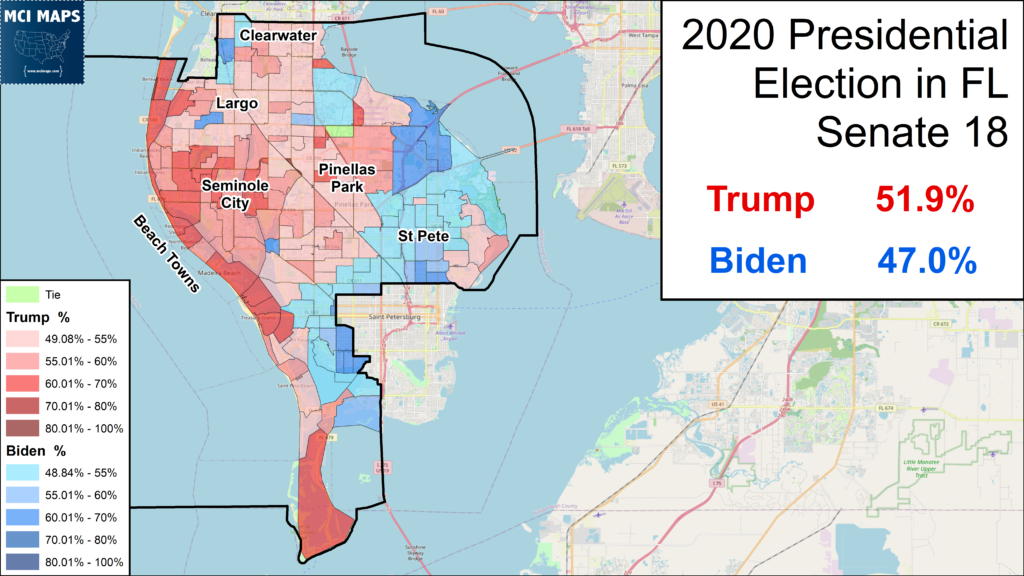
The district backed Bill Nelson in the 2018 Senate race thanks to Nelson’s white working-class overperformance. The district has a great deal more elasticity than many other parts of the state, but still have an overall GOP lean.
Two things are keeping this district out of safe GOP column. First, Democratic Gubernatorial Candidate Charlie Crist will almost surely carry the seat. He won the district by 8 points in 2014.
This is is home base of support and is covered by his current Congressional district. However, his winning of the district does not mean everything will translate down-ballot; as it often doesn’t. If the democrats didn’t have a strong recruit, this district would easily be SAFE GOP. However, Democratic nominee Eunic Ortiz, who works for the SEIU and is an LGBT activist, is exciting many democrats in the region. Ortiz has proven to be a very strong candidate, raising $320,000 so far. She has gotten outside help from activists and independent groups, but the race is not a top Democratic target. Her opponent, Republican State Rep Nick DiCeglie, is still the frontrunner, however. He has raised over $1.3 million for his race.
Ortiz is making DiCeglie work for his seat, but the district is still likely to vote GOP for most top-of-the-ballot races; with Governor being a clear exception. The down-ballot GOP advantage is a massive hurdle for Ortiz to overcome.
The Safe Districts
All remaining districts are SAFE for either the Democrats or Republicans. A large number of seats are unopposed or have criminally underfunded opposition. Overall, these are my ratings for the 2022 State Senate.
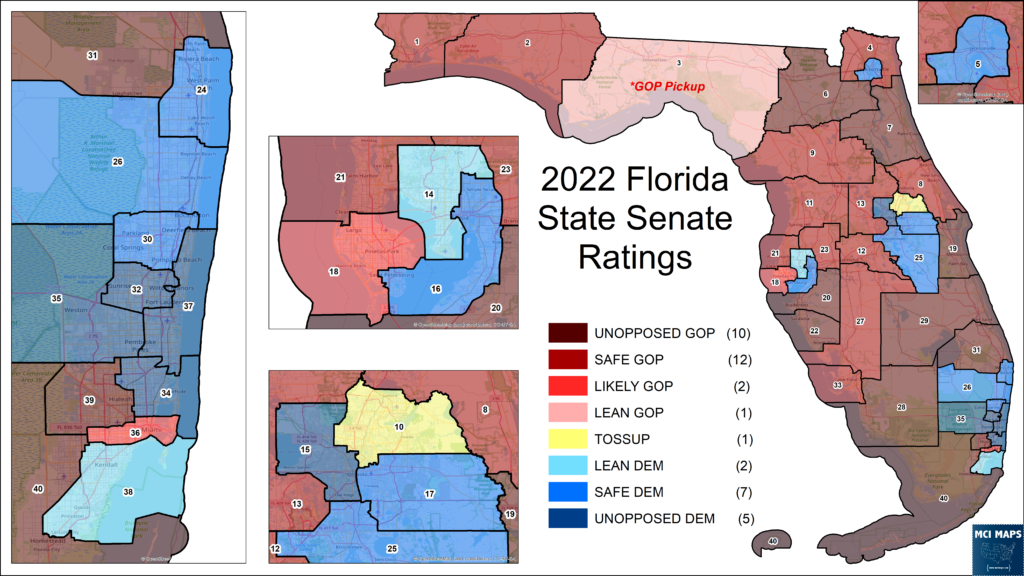
Democrats are likely on course for 14-15 or so seats. If they are super lucky, they could get to 16 seats, but could also easily fall to 12-13. Its a long road ahead for Senate Democrats.



